人教版高中英语必修二 UNIT 1 Period VI Video Time & Assessing Your Progress(课件)
文档属性
| 名称 | 人教版高中英语必修二 UNIT 1 Period VI Video Time & Assessing Your Progress(课件) | 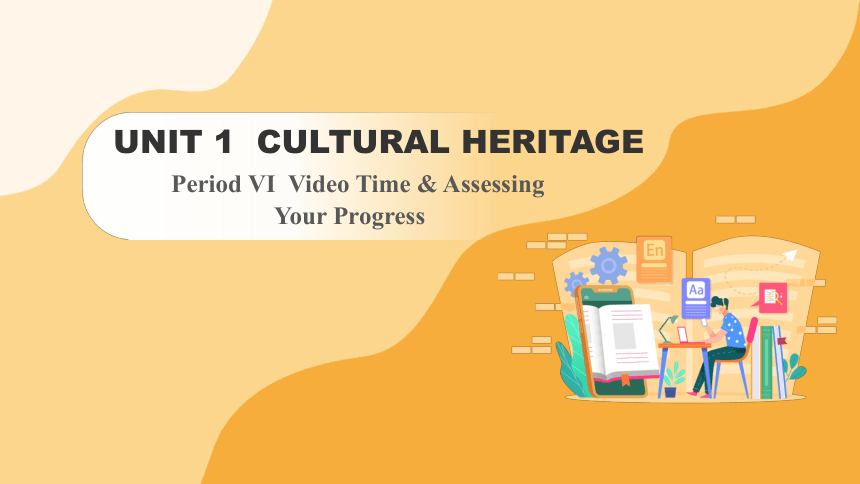 | |
| 格式 | pptx | ||
| 文件大小 | 2.8MB | ||
| 资源类型 | 试卷 | ||
| 版本资源 | 人教版(2019) | ||
| 科目 | 英语 | ||
| 更新时间 | 2023-12-05 21:13:18 | ||
图片预览



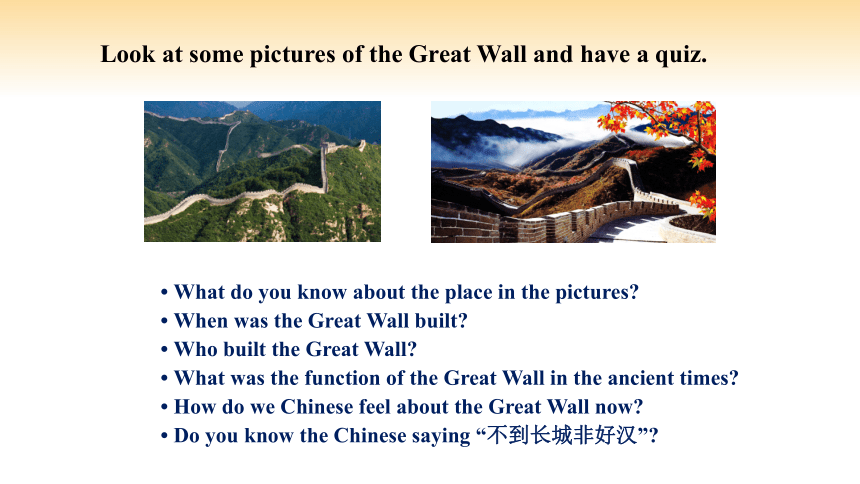
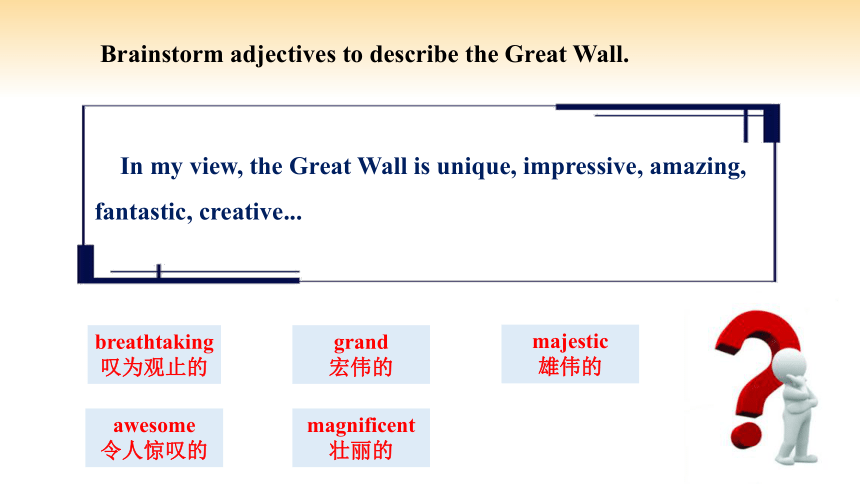
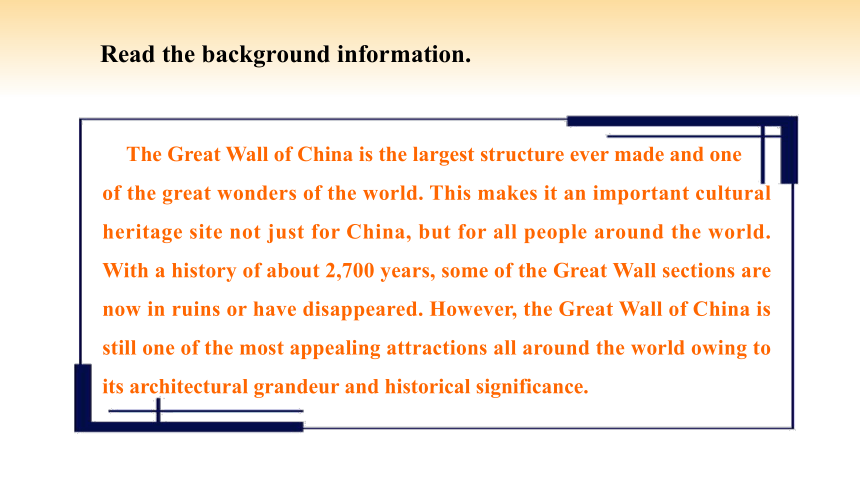
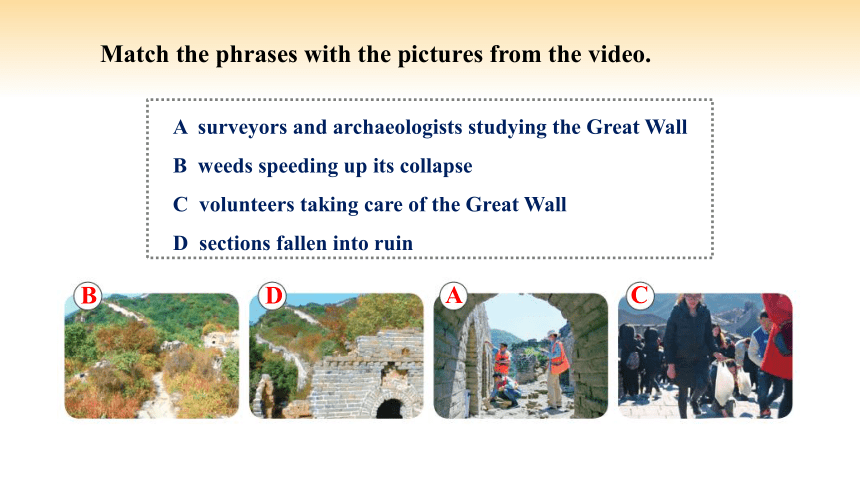
文档简介
(共18张PPT)
UNIT 1 CULTURAL HERITAGE
Period VI Video Time & Assessing
Your Progress
Step I 学习理解
Predict the content of the video according to the title and the picture.
The Great Wall
The Great Wall of China is the largest structure ever made and one of the great wonders of the world. This makes it an important cultural heritage site not just for China, but for all people around the world.
Look at some pictures of the Great Wall and have a quiz.
What do you know about the place in the pictures
When was the Great Wall built
Who built the Great Wall
What was the function of the Great Wall in the ancient times
How do we Chinese feel about the Great Wall now
Do you know the Chinese saying “不到长城非好汉”
Brainstorm adjectives to describe the Great Wall.
In my view, the Great Wall is unique, impressive, amazing, fantastic, creative...
breathtaking
叹为观止的
grand
宏伟的
majestic
雄伟的
awesome
令人惊叹的
magnificent壮丽的
Read the background information.
The Great Wall of China is the largest structure ever made and one
of the great wonders of the world. This makes it an important cultural heritage site not just for China, but for all people around the world. With a history of about 2,700 years, some of the Great Wall sections are now in ruins or have disappeared. However, the Great Wall of China is still one of the most appealing attractions all around the world owing to its architectural grandeur and historical significance.
Match the phrases with the pictures from the video.
A surveyors and archaeologists studying the Great Wall
B weeds speeding up its collapse
C volunteers taking care of the Great Wall
D sections fallen into ruin
B
D
A
C
Read the statements and decide whether they are true (T) or false (F).
点击按钮播放视频
1. Every part of the Great Wall is easy to find and see.
2. The Great Wall took 2,300 years to build.
3. Some of the Great Wall has been lost.
4. The length of the Great Wall is the same as the distance
between the North and South Poles.
□
□
□
□
F
T
T
T
Discuss the questions in pairs.
Who take part in protecting the Great Wall
Who do the people mentioned in the video protect cultural heritage for
Mei Jingtian who/that has been taking care of the Great Wall for 30 years, surveyors and archaeological experts as well as college students who work as volunteers.
For Chinese people and international people.
Step II 应用实践
Watch the video again and complete the sentences with the words you hear in the video.
点击按钮播放视频
1. We are __________ and we usually come here once a month.
2. But when we are not busy with school, we come here ______
________________.
3. We hope more people will protect our _________________.
4. We need to protect the Great Wall, so we can present it to the
future generations and let our cultural imprint _________.
volunteers
once
every two weeks
cultural heritage
live on
Discuss the questions in groups and voice your opinions.
Why should we protect the Great Wall
How do the people mentioned in the video protect the Great Wall
What can you do to protect the Great Wall
Because each section of the Great Wall records its transformation through the years and has incomparable historical value. Besides, the Great Wall means the memories and strong emotions from the ancient times. Last but not least, we can present it to the future generations and let our cultural imprint live on.
Pull weeds, survey the length, pick up the rubbish.
Take photos, never throw rubbish, know more about the Great Wall and tell its history and story to people around and foreigners, work as volunteers...
Complete the phrases.
in to from a balance sure
be proud ________ keep ________ prevent ________
donate sth ________ lead ________ take part ________
make ________ turn ________
to
a balance
from
to
to
in
sure
to
How can you take part in cultural heritage protection Read the passage, use the phrases above to finish the passage.
Getting young people to ____________ activities to protect their national heritage is a good way to introduce them to their country’s history. As they learn more about where they come from, they will hopefully ____________ tell others about their country and culture. Of course, teachers must ______________ between teaching the good and bad parts of a country’s history. Learning only the good parts can _______ narrow thinking. Learning the bad parts may help __________ those kinds of things _______ happening again. Students who know their history and culture are more likely to _____________ that their cultural heritage is protected, and teachers can motivate students by asking them to come up with their own ideas and make proposals for ways to protect this. One possible idea is for students to raise or ________ money _______ an organisation or group that protects their country’s cultural heritage. Teachers may also _________ their local museums or historical societies for help in getting students more interested in this important field.
take part in
be proud to
keep a balance
lead to
prevent
from
make sure
donate
to
turn to
Step III 迁移创新
Read the passage in Activity 1 again and finish the following tasks.
Get young people to take part in activities.
Teachers teach history and motivate students.
Raise or donate money.
Teachers turn to local museums or historical societies for help.
List methods to take part in cultural heritage protection.
What can you do to protect the cultural heritage
We may join in an organisation of cultural protection/become a volunteer in a local museum/learn some skills of protecting it/choose some relevant majors in college...
A: My teacher just gave us a task _____________ I really don’t know how to do. I
have to take part in an organisation ____________ protects our cultural heritage.
B: Oh, that sounds interesting! Where are you planning to go I’m sure there are all
kinds of historic sites ______________ cultural relics need to be protected.
A: Yes, but I’m not one of those people _______ love museums. I think they’re kind
of boring. I like going on field trips _________________ I can experience and do
things to protect cultural relics.
B: Cultural heritage is a lot more than just relics, you know. For example, our country
has many nationalities ________ dances, crafts, and other traditions are also very
important. If we don’t protect those traditions, there may come a time ______ they
disappear.
(that/which)
Read the conversation and learn about intangible cultural heritage (ICH). Then complete it with the correct relative pronouns or adverbs.
that/which
where/whose
who
where/on which
whose
when
Reflecting.
What have you learnt in this unit
Did you find it easy or difficult to talk about culture and history
Why or why not
What was the most interesting part of this unit and why
How does learning about cultural heritage affect your opinion about
your role in protecting your culture
UNIT 1 CULTURAL HERITAGE
Period VI Video Time & Assessing
Your Progress
Step I 学习理解
Predict the content of the video according to the title and the picture.
The Great Wall
The Great Wall of China is the largest structure ever made and one of the great wonders of the world. This makes it an important cultural heritage site not just for China, but for all people around the world.
Look at some pictures of the Great Wall and have a quiz.
What do you know about the place in the pictures
When was the Great Wall built
Who built the Great Wall
What was the function of the Great Wall in the ancient times
How do we Chinese feel about the Great Wall now
Do you know the Chinese saying “不到长城非好汉”
Brainstorm adjectives to describe the Great Wall.
In my view, the Great Wall is unique, impressive, amazing, fantastic, creative...
breathtaking
叹为观止的
grand
宏伟的
majestic
雄伟的
awesome
令人惊叹的
magnificent壮丽的
Read the background information.
The Great Wall of China is the largest structure ever made and one
of the great wonders of the world. This makes it an important cultural heritage site not just for China, but for all people around the world. With a history of about 2,700 years, some of the Great Wall sections are now in ruins or have disappeared. However, the Great Wall of China is still one of the most appealing attractions all around the world owing to its architectural grandeur and historical significance.
Match the phrases with the pictures from the video.
A surveyors and archaeologists studying the Great Wall
B weeds speeding up its collapse
C volunteers taking care of the Great Wall
D sections fallen into ruin
B
D
A
C
Read the statements and decide whether they are true (T) or false (F).
点击按钮播放视频
1. Every part of the Great Wall is easy to find and see.
2. The Great Wall took 2,300 years to build.
3. Some of the Great Wall has been lost.
4. The length of the Great Wall is the same as the distance
between the North and South Poles.
□
□
□
□
F
T
T
T
Discuss the questions in pairs.
Who take part in protecting the Great Wall
Who do the people mentioned in the video protect cultural heritage for
Mei Jingtian who/that has been taking care of the Great Wall for 30 years, surveyors and archaeological experts as well as college students who work as volunteers.
For Chinese people and international people.
Step II 应用实践
Watch the video again and complete the sentences with the words you hear in the video.
点击按钮播放视频
1. We are __________ and we usually come here once a month.
2. But when we are not busy with school, we come here ______
________________.
3. We hope more people will protect our _________________.
4. We need to protect the Great Wall, so we can present it to the
future generations and let our cultural imprint _________.
volunteers
once
every two weeks
cultural heritage
live on
Discuss the questions in groups and voice your opinions.
Why should we protect the Great Wall
How do the people mentioned in the video protect the Great Wall
What can you do to protect the Great Wall
Because each section of the Great Wall records its transformation through the years and has incomparable historical value. Besides, the Great Wall means the memories and strong emotions from the ancient times. Last but not least, we can present it to the future generations and let our cultural imprint live on.
Pull weeds, survey the length, pick up the rubbish.
Take photos, never throw rubbish, know more about the Great Wall and tell its history and story to people around and foreigners, work as volunteers...
Complete the phrases.
in to from a balance sure
be proud ________ keep ________ prevent ________
donate sth ________ lead ________ take part ________
make ________ turn ________
to
a balance
from
to
to
in
sure
to
How can you take part in cultural heritage protection Read the passage, use the phrases above to finish the passage.
Getting young people to ____________ activities to protect their national heritage is a good way to introduce them to their country’s history. As they learn more about where they come from, they will hopefully ____________ tell others about their country and culture. Of course, teachers must ______________ between teaching the good and bad parts of a country’s history. Learning only the good parts can _______ narrow thinking. Learning the bad parts may help __________ those kinds of things _______ happening again. Students who know their history and culture are more likely to _____________ that their cultural heritage is protected, and teachers can motivate students by asking them to come up with their own ideas and make proposals for ways to protect this. One possible idea is for students to raise or ________ money _______ an organisation or group that protects their country’s cultural heritage. Teachers may also _________ their local museums or historical societies for help in getting students more interested in this important field.
take part in
be proud to
keep a balance
lead to
prevent
from
make sure
donate
to
turn to
Step III 迁移创新
Read the passage in Activity 1 again and finish the following tasks.
Get young people to take part in activities.
Teachers teach history and motivate students.
Raise or donate money.
Teachers turn to local museums or historical societies for help.
List methods to take part in cultural heritage protection.
What can you do to protect the cultural heritage
We may join in an organisation of cultural protection/become a volunteer in a local museum/learn some skills of protecting it/choose some relevant majors in college...
A: My teacher just gave us a task _____________ I really don’t know how to do. I
have to take part in an organisation ____________ protects our cultural heritage.
B: Oh, that sounds interesting! Where are you planning to go I’m sure there are all
kinds of historic sites ______________ cultural relics need to be protected.
A: Yes, but I’m not one of those people _______ love museums. I think they’re kind
of boring. I like going on field trips _________________ I can experience and do
things to protect cultural relics.
B: Cultural heritage is a lot more than just relics, you know. For example, our country
has many nationalities ________ dances, crafts, and other traditions are also very
important. If we don’t protect those traditions, there may come a time ______ they
disappear.
(that/which)
Read the conversation and learn about intangible cultural heritage (ICH). Then complete it with the correct relative pronouns or adverbs.
that/which
where/whose
who
where/on which
whose
when
Reflecting.
What have you learnt in this unit
Did you find it easy or difficult to talk about culture and history
Why or why not
What was the most interesting part of this unit and why
How does learning about cultural heritage affect your opinion about
your role in protecting your culture
